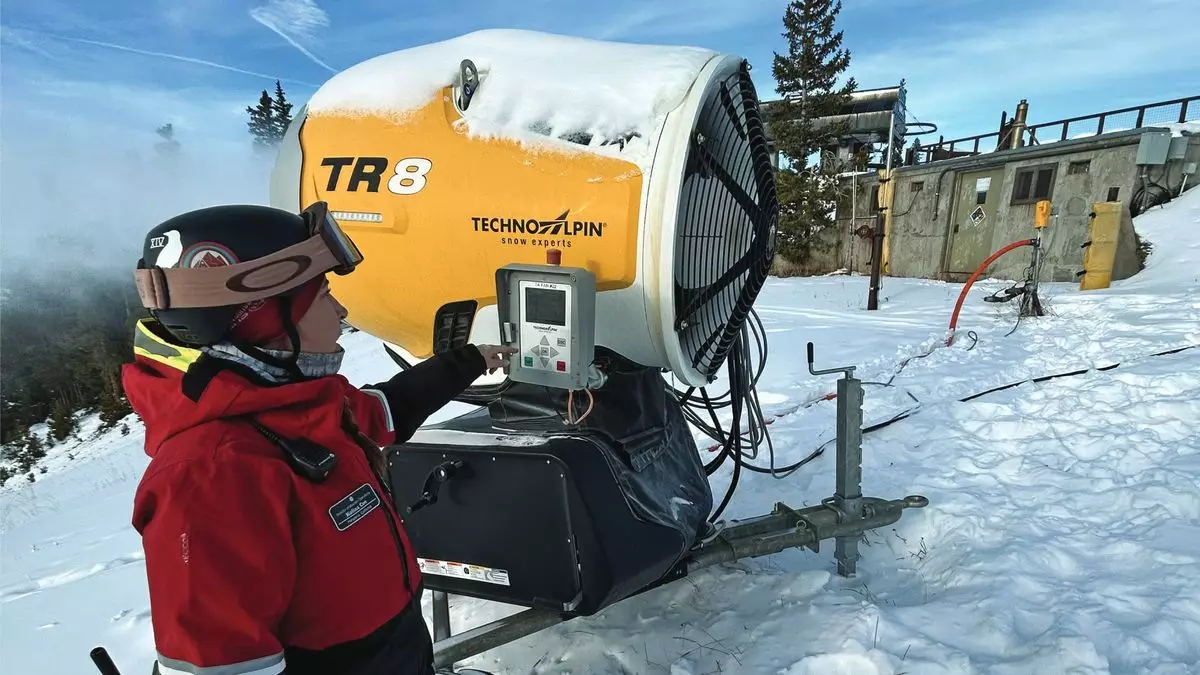As winter approaches, ski resorts across the United States gear up for the bustling season ahead. One notable player in this preparation is Keystone Resort in Colorado, where the art and science of snowmaking is pivotal to ensuring a successful ski season. Standing at an elevation of 11,640 feet on Dercum Mountain, the intricate workings of snowmaking machinery unveil a compelling narrative of adaptation and innovation in the ski industry.
In the early hours of a chilly November day, the resort showcases its impressive snowmaking capabilities. With tools from the Italy-based manufacturer TechnoAlpin, mobile fan guns spray a fine mist that rapidly transforms into snow, thanks to optimal conditions: a cool air temperature of 32.9 degrees Fahrenheit and low humidity levels. The ‘wet-bulb temperature’ drops to 21.7 degrees, making it an ideal setting for producing artificial snow. As snowmaking operations directors, Kate Schifani and Kolina Coe, observe this process, their excitement underscores the significance of snowmaking technology—highlighting the critical role it plays in launching the ski season earlier and ensuring a consistent snow base for visitors.
The reliance on snowmaking is not solely for entertainment; it represents a financial strategy for ski resorts. With skiable terrain at around 3,148 acres, an extensive snowmaking infrastructure allows Keystone to extend its operating season and enhance overall profitability. The addition of 672 fixed and mobile snow guns demonstrates a commitment to providing visitors with an enjoyable skiing experience, regardless of natural snowfall conditions.
In recent years, Keystone has undertaken a significant upgrading of its snowmaking infrastructure. A notable advancement came in 2019 with the introduction of 53 state-of-the-art snowmaking machines and the installation of enhanced water pipelines. Beyond just aesthetics, these innovations have improved Keystone’s average opening date from November 8th to a remarkable October 27th. This advancement not only boosts the resort’s reputation but also aligns with a growing trend among ski areas to harness technology effectively.
Keystone is not alone in its pursuits. Resorts throughout the country are recognizing the importance of snowmaking, with sustained social media presence highlighting their efforts to attract visitors during the snowy months. The objective is to create an engaging experience for ski enthusiasts while simultaneously dealing with the pressing challenges presented by climate change.
Climate change poses a significant threat to ski resorts worldwide, putting pressure on them to adopt more sustainable practices. The challenge of producing snow efficiently while minimizing environmental impact is a critical focus. Vail Resorts, the parent company of Keystone, aims for a carbon-neutral operation by 2030, which includes leveraging 100% renewable electricity at its North American resorts. Such ambitious goals highlight a paradigm shift in the ski industry towards prioritizing environmental stewardship.
Snowmaking operations are evolving with a lean towards automation; approximately half of Keystone’s snowmaking stations are now equipped with automated systems. These innovations not only expedite the activation of snow guns—reducing deployment time from two hours to mere minutes—but also ensure better utilization of weather conditions, maximizing snow yield with minimal resource waste.
Additionally, with automated snowmaking, the consistency and quality of snow production improve, leading to more efficient use of water and energy. This revival in snowmaking technology signals an important evolution that underscores the industry’s commitment to sustainability. As Keystone invests in further automating its operations, there is considerable promise for significant energy efficiencies akin to those reported by nearby Vail Mountain.
The ongoing enhancements in snowmaking at Keystone Resort are part of a broader strategy to develop a climate-resistant business model. As Schifani articulates, ensuring the reliable opening of the ski season is not only about business but also about nurturing a community of loyal guests. By promoting a consistent skiing environment, the resort aims to safeguard its future and attract an ever-growing base of ski enthusiasts.
Ultimately, the evolution of snowmaking technology, coupled with sustainable practices, is reshaping the ski industry. Keystone Resort, with its innovations and strategic foresight, stands as a beacon for other resorts grappling with climate uncertainties. Skiers and snowboarders can look forward to hitting the slopes earlier and enjoying reliable snow conditions, thanks to the commitment to smart, sustainable snowmaking practices. The fusion of technology and environmental responsibility may well define the future of skiing, ensuring that generations of winter sport lovers can enjoy the thrill of the slopes for years to come.


Leave a Reply